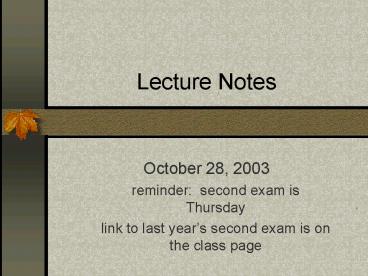Lecture Notes - PowerPoint PPT Presentation
1 / 21
Title: Lecture Notes
1
Lecture Notes
- October 28, 2003
- reminder second exam is Thursday
- link to last years second exam is on the class
page
2
Chapter 8
- Why Do Economies Grow?
3
Reasons for Growth in Per-capita GDP
- (proximate reasons)
- capital deepening (increases in capital per
capita) - Technological change
- Evidence that TC is more important rapid
recovery of Germany, Japan, Italy from World War
II. - Capital deepening would lead you to expect high
growth rates, but not that the losers of WWII
would end up doing better than the winners!
4
Capital Deepening
- (Careful a high capital stock per worker
produces high output/worker, but not increasing
output/worker - An increasing capital stock/worker produces
increasing output/worker) - What determines whether capital deepening occurs?
- Saving vs. depreciation and population growth
- High rate of saving means capital stock per
worker will reach a high level
5
Limits to capital deepening
- With a given saving rate, no matter how high,
its cant continue indefinitely depreciation
increases
6
Solow model (appendix)
- A dynamic version of the classical model
- (dynamic involves time)
- Individuals have a constant saving rate (as a
proportion of income - Depreciation is a constant proportion of capital
- Low capital per capita saving ( investment)
exceeds depreciation, so that capital stock per
worker increases
7
Solow Model
- From the aggregate production function, can graph
output/worker as a function of capital/worker
8
- With a constant saving rate, saving/worker has
the same shape. - Savings are allocated between (1) replacing
depreciated capital and (2) capital deepening - Depreciation is proportional to capital
9
Solow model
10
Steady state
- The economy converges to a point where
depreciation fully absorbs saving. - Capital stock per worker stops growing
- Conclusion high saving can only increase the
growth rate temporarily (although temporarily
may be many years) - Japan
11
Population growth
- Plays the same role as depreciation
- New saving goes to
- replacing depreciated capital
- capital widening (equipping the new population
with capital) - capital deepening
- Rapid population growth results in lower
steady-state capital.
12
Technological Progress
- Affects growth permanently (unlike an increase in
saving) - Closely related to quality change to the extent
that the technology changes, the quality of
consumer and product goods changes. - Govt tries to allow for this in measuring real GDP
13
Tech. change as a contributor to GDP growth
- From aggregate production function, GDP growth is
due to - Increases in capital, labor inputs
- quality adjusted
- Shifts in the production function due to
technological change - (Note this breakdown is ambiguous to the extent
that quality change in capital goods is due to
tech. change.)
14
Growth Accounting
- They try to measure these, analyze the sources of
real GDP growth. - Tech. change is in effect a residual
- Most of GDP growth is due to tech. change.
15
Labor Productivity
- GDP per manhour
- Productivity slowdown
- Productivity growth slowed in 70s, 80s.
- Why?
- Now (1995 on) growth has resumed at the normal
rate or higher! - Computers incorporated in business?
16
Labor hoarding
- During a recession, firms decrease production.
- Are reluctant to lay off workers (very costly to
rehire) - So measured labor productivity drops.
17
Human Capital
- A major determinant of tech. change
- Labor input is like the (physical) capital input
in most respects - Productivity of labor depends on expenditures on
education - Big increase in returns to education
- Fewer and fewer blue-collar jobs badly paid.
- Saving rate should include expenditure on
education
18
Classical Economics
- Review classical economics prices, wages,
etc. are flexible. - At best, this describes what happens in the long
run (after prices have adjusted) - Conclusion what is the long-run effect of
fiscal, monetary policy on real GDP? - None. In the long-run real GDP is determined in
the labor market. - Fiscal, monetary policy affect inflation and the
composition of GDP, of course.
19
Short run
- How long is the long run? Months? Years?
Decades? - Keynesian economists think the short run can last
quite a long time - Keynes In the long run we are all dead.
- So government policy should try to stabilize GDP
over the short run - Classical economists this is likely to do more
harm than good
20
Keynesian economics
- We should look at a classical model, and see what
happens when prices dont adjust. - Too hard.
- So instead well discuss a simple Keynesian model
in which the classical conclusions dont hold - Wont connect it with the classical model at all.
- advantage easier
- disadvantage you dont have an easy way to
focus on where classical, Keynesian economics
differ
21
What is Keynesian economics?
- Price-wage rigidity?
- No sign of price rigidity in 1932,
- This couldnt be what was wrong with the
classical model - Insofar as Keynesian models require wage
rigidity, they dont give good explanations for
Great Depression - Bottom line its not obvious that Keynesian
economics makes any sense - Not obvious exactly how it differs from
classical.































